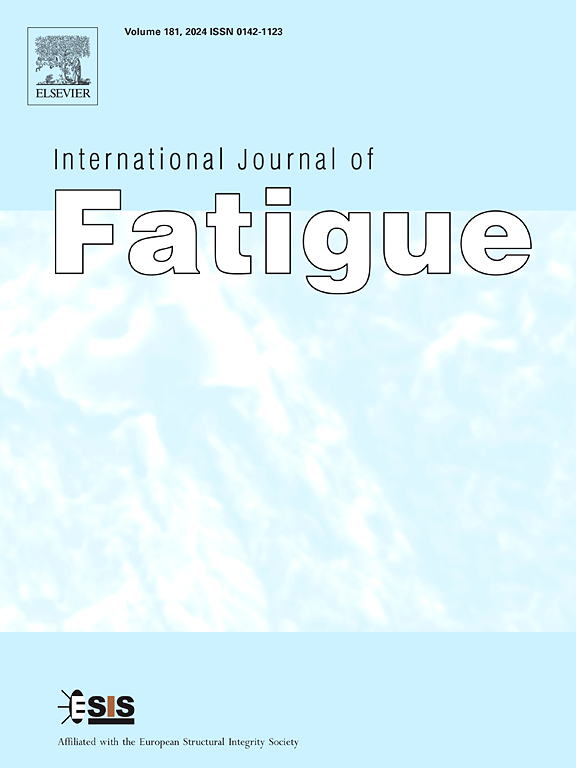循环荷载下复合损伤对CFRP/钢粘结节点性能的影响
IF 5.7
2区 材料科学
Q1 ENGINEERING, MECHANICAL
引用次数: 0
摘要
高性能胶粘剂,具有增强断裂韧性,允许增强CFRP/钢接头的应力传递机制,从而提高钢筋的开发率。虽然现有的方法假设复合材料的机械性能不受循环载荷的影响,但在接近其静强度的大应力水平下,CFRP材料可能会表现出疲劳损伤。本文从实验和数值两方面研究了CFRP循环损伤对CFRP/钢粘结节点疲劳性能的影响。采用剩余刚度法对CFRP板的循环非线性行为进行了建模。该模型与循环黏结律相结合,考虑了CFRP/钢界面的行为。通过CFRP片材的循环拉伸试验和CFRP/钢节点的单搭接直剪疲劳试验对模型参数进行了标定。参数分析是通过改变主要设计参数来进行的。结果表明,碳纤维布加固的疲劳损伤对节点响应有重要影响。破坏发生在胶粘剂内的薄层粘性脱粘,局部发生在CFRP一侧附近。研究发现,复合材料的疲劳退化显著减少了失效循环次数,特别是在低疲劳载荷范围内。本文章由计算机程序翻译,如有差异,请以英文原文为准。
Influence of composite damage on CFRP/steel bonded joint behaviour under cyclic loadings
High performance adhesives, with augmented fracture toughness, allow to enhance the stress-transfer mechanism in CFRP/steel joints, thus increasing the rate of exploitation of the reinforcement. While existing approaches assume that the mechanical properties of the composite are not affected by the cyclic loading, at large stress levels, close to their static strength, CFRP materials could instead exhibit fatigue damage. In this paper, the influence of CFRP cyclic damage on the fatigue behaviour of CFRP/steel bonded joints is investigated both experimentally and numerically. A residual stiffness method is adopted to model the cyclic nonlinear behaviour of the CFRP lamina. This model is coupled with a cyclic cohesive law accounting for the behaviour of the CFRP/steel interface. The models’ parameters are calibrated using cyclic tensile tests on CFRP coupons and single lap direct shear fatigue tests of the CFRP/steel joints. Parametric analyses are performed by varying the main design parameters. The results show that fatigue damage in the CFRP reinforcement plays a significant role in the joint response. Failure occurred by thin-layer cohesive debonding within the adhesive, localized near the CFRP side. Composite fatigue degradation was found to significantly reduce the number of cycles to failure, especially at low fatigue load ranges.
求助全文
通过发布文献求助,成功后即可免费获取论文全文。
去求助
来源期刊

International Journal of Fatigue
工程技术-材料科学:综合
CiteScore
10.70
自引率
21.70%
发文量
619
审稿时长
58 days
期刊介绍:
Typical subjects discussed in International Journal of Fatigue address:
Novel fatigue testing and characterization methods (new kinds of fatigue tests, critical evaluation of existing methods, in situ measurement of fatigue degradation, non-contact field measurements)
Multiaxial fatigue and complex loading effects of materials and structures, exploring state-of-the-art concepts in degradation under cyclic loading
Fatigue in the very high cycle regime, including failure mode transitions from surface to subsurface, effects of surface treatment, processing, and loading conditions
Modeling (including degradation processes and related driving forces, multiscale/multi-resolution methods, computational hierarchical and concurrent methods for coupled component and material responses, novel methods for notch root analysis, fracture mechanics, damage mechanics, crack growth kinetics, life prediction and durability, and prediction of stochastic fatigue behavior reflecting microstructure and service conditions)
Models for early stages of fatigue crack formation and growth that explicitly consider microstructure and relevant materials science aspects
Understanding the influence or manufacturing and processing route on fatigue degradation, and embedding this understanding in more predictive schemes for mitigation and design against fatigue
Prognosis and damage state awareness (including sensors, monitoring, methodology, interactive control, accelerated methods, data interpretation)
Applications of technologies associated with fatigue and their implications for structural integrity and reliability. This includes issues related to design, operation and maintenance, i.e., life cycle engineering
Smart materials and structures that can sense and mitigate fatigue degradation
Fatigue of devices and structures at small scales, including effects of process route and surfaces/interfaces.
 求助内容:
求助内容: 应助结果提醒方式:
应助结果提醒方式:


